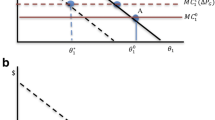Abstract
Because it is difficult to monitor emissions and to implement differentialtaxes and standards, uniform taxes and standards on agricultural chemicaluse are often proposed and used to control nonpoint-source pollution. Thisarticle analyzes the relative efficiency of these uniform instruments in thepresence of spatial heterogeneity. We show that the relative slopes of themarginal pollution cost and marginal profit of chemical use are only one ofthe factors that affect the relative efficiency. Other factors includecorrelation between marginal pollution costs and marginal profits and theslope and variability of marginal profits. In addition, a uniform tax mayresult in some farmers not using the chemical, and a uniform standard mayhave no effect on low-input land. We show empirically that the presence ofcorner solutions can reverse a conventional finding of tax or standardsuperiority based on the relative-slop rule.
Similar content being viewed by others
REFERENCES
Adar, Z. and J. M. Griffin (1976), ‘Uncertainty and the Choice of Pollution ControlInstruments’, J. Environ. Econom. Management 3, 178–188.
Babcock, B. A. and A. M. Blackmer(1992), ‘The Value of Reducing Temporal Input Nonuniformities’, J. Agric. Resou. Econom. 17, 335–347.
Bouzaher, A., P.G. Lakshminarayan, R. Cabe, A. Carriquiry, P.W. Gassman and J. F. Shogren(1993), ‘Metamodels and Nonpoint Pollution Policy in Agriculture’, Water Resour. Res. 29,1579–1587.
Caswell, M., E. Lichtenberg and D. Zilberman (1990), ‘The Effects of Pricing Policies on WaterConservation and Drainage’,Amer. J. Agric Econom. 72,883–890.
Dasgupta, P., P. J. Hammondand E. Maskin (1980), ‘A Note on Imperfect Information and Optimal Pollution Control’, Rev. Econm. Studies 47, 857–860.
Fishelson, G. (1976), ‘Emission Control Policies under Uncertainty’, J.Environ. Econom. Management 3, 189–197.
Griffin, R. C. and D. W. Bromley (1982),‘Agricultural Runoff as a Nonpoint Externality: A Theoretical Development’, Amer. J. Agric. Econom 64, 547–552.
Helfand, G. E. and B. W. House (1995), ‘Regulating Nonponit Source Pollution UnderHeterogeneous Conditions’, Amer. J. Agric. Econom. 77,1024–1032.
Hertel, T. W., K. Stiegert and H. Vroomen (1996), ‘Nitrogen-Land Substitution in Corn Production: A Reconciliation of Aggregate and Firm-Level Evidence’, Amer. J. Agric. Econom. 78, 30–40.
Johnson, S. L.,R.M. Adams and G.M. Perry (1991), ‘The On-Farm Costs of Reducing Groundwater Pollution’,Amer. J. Agric. Econom. 73, 1063–1072.
Kwerel, E. (1977), ‘To Tell the Truth: Imperfect Information and OptimalPollution Control’, Rev. Econom. Studies 44, 595–601.
Mapp, H. P., D. J. Bernardo, G.J. Sabbagh, S. Geleta and K. B. Watkins (1994), ‘Economic And Environmental Impacts of Limiting Nitrogen Use To Protect Water Quality: A Stochastic Regional Analysis’,Amer. J. Agric. Econom. 76, 889–903.
Malcomson, J. M. (1978), ‘Prices vs. Quantities: A Critical Note on the Use of Approximations’, Rev. ofEconom. Studies 68, 203–207.
Roberts, M. J. and M. Spence (1976), ‘Effluent Charges andLicences under Uncertainty’, J. Public Econom.5, 193–208.
Segerson, K. (1988), ‘Uncertainty andIncentives for Nonpont Pollution Control’, J. Environ. Econom. Management 15, 87–98.
Shortle, J. S.and J.W. Dunn (1986), ‘The Relative Efficiency of Agricultural SourceWater Pollution Control Policies’, Amer. J. Agric. Econom. 68, 668–677.
Stavins, R. N. (1996), ‘Correlated Uncertainty and PolicyInstrument Choice’, J. Environ. Econom. Management 30, 218–232.
Taylor, M. L., R. M. Adamsand S. F. Miller (1992), ‘Farm-Level Response to Agricultural Effluent Control Strategies: The Case of the Willamette Valley’,J. Agric. Resour. Econom. 17, 173–185.
Weitzman, M. L. (1974), ‘Prices vs.Quantities’, Rev. Econom. Studies 41, 477–491.
Wu, J. J. and B. A. Babcock (1996), ‘ContractDesign for the Purchase of Environmental Goods from Agricutlure’, Amer. J. Agric. Econom. 78, 935–945.
Wu, J. J., H. P. Mapp and D. J. Bernardo (1994), ‘A Dynamic Analysis of the Impact ofWaterQuality Policies on Irrigation Investment and Crop Choice Decisions’,J. Agric. and Applied Econom. 26, 506–525.
Wu, J. J., M. L. Teague, H. P. Mapp and D. J. Bernardo (1995), ‘An Empirical Analysis ofthe Relative Efficiency of Policy Instruments to Reduce NitrateWater Pollution in the U.S. Southern High Plains’, Canad. J. Agric. Econom. 43,403–420.
Xepapadeas, A. P. (1991), ‘Environmental Policy underImperfect Information: Incentives and Moral Hazard’,J. Environ. Econom. Manage. 20, 113–126.
Xepapadeas, A. P. (1994), ‘Controlling Environmental Externalities: Observability and Optimal Policy Rules’,in C. Dosi and T. Tomasi, eds., Nonpoint Source Pollution Regulation: Issues and Analysis. Dordrecht and Boston: Kluwer Academic, pp.67–85.
Xepapadeas, A. P. (1995), ‘Observability and Choice of InstrumentMix in the Control of Externalities’, J. Environ. Econom Manage. 56(3),485–498.
Yohe, G. (1976),‘Substitution and the Control of Pollution: A Comparison of Effluent Charges and Quantity Standards under Uncertainty’, J. Environ. Econom. Management 3, 312–324.
Author information
Authors and Affiliations
Rights and permissions
About this article
Cite this article
Wu, J., Babcock, B.A. Spatial Heterogeneity and the Choice of Instruments to Control Nonpoint Pollution. Environmental and Resource Economics 18, 173–192 (2001). https://doi.org/10.1023/A:1011164102052
Issue Date:
DOI: https://doi.org/10.1023/A:1011164102052




